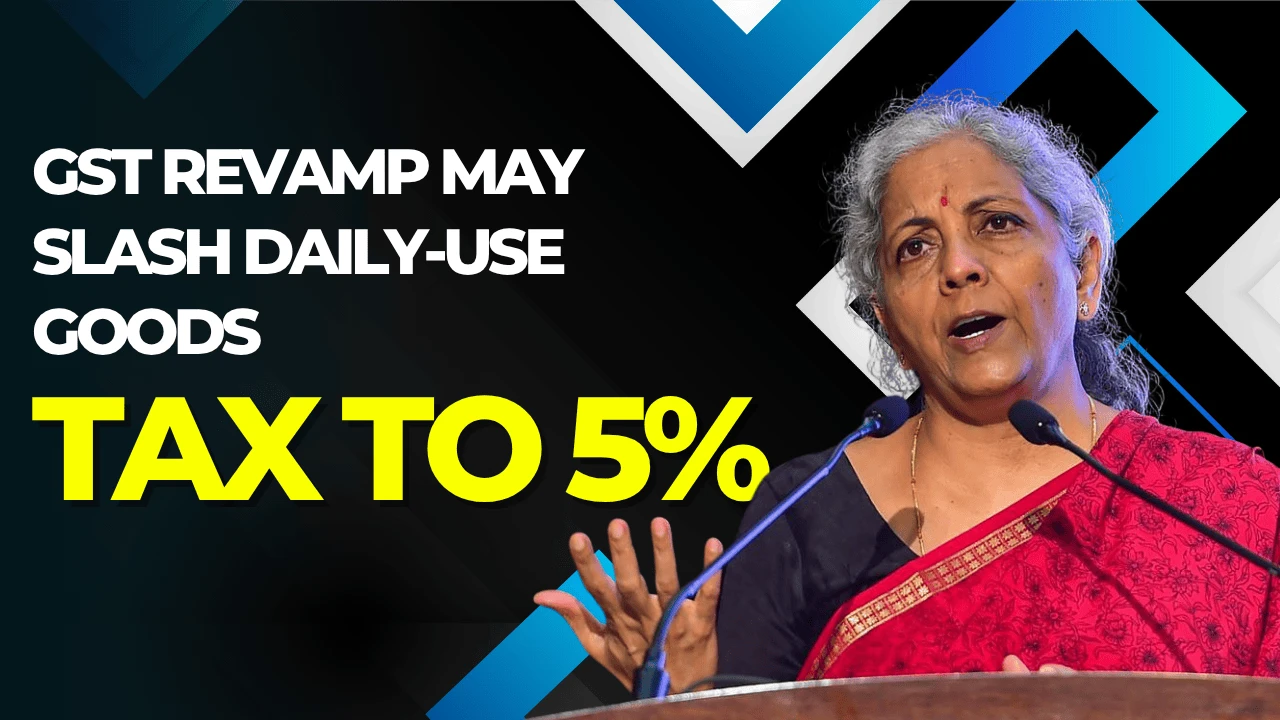Listen to This Article
GST Revamp May Slash Daily-Use Goods Tax from 12% to 5%, Major Relief Likely This Month
In a significant move that could ease the financial burden on millions of Indian households, the government is reportedly considering a major overhaul of the Goods and Services Tax (GST) structure.Sources indicate that the proposed GST overhaul could reduce the tax on daily-use goods from 12% to 5%, offering significant relief to consumers. This potential tax major relief is expected to be announced this month, signaling a much-needed respite amid persistent inflationary pressures.
Why Is a GST Revamp Necessary Now?
Since its launch in 2017, GST has transformed indirect taxation in India, simplifying the complex web of state and central taxes. However, over the years, criticisms have grown around the tax burden on essential daily-use items. Prices of household staples such as packaged food, toiletries, and basic kitchen supplies continue to strain middle-class and lower-income families. The current 12% GST slab on many of these goods has long been a sore point.
With inflation eroding purchasing power, the government’s willingness to consider a GST rate reduction reflects its intention to provide direct relief to consumers and stimulate demand. Experts believe that by lowering GST on essential items, household expenses can ease significantly, injecting more disposable income into the economy.
What Goods Could See Lower GST Rates?
Sources suggest that if the revamp may slash the tax rates as expected, the following categories could be impacted:
-
Packaged foods: Ready-to-eat meals, instant noodles, breakfast cereals.
-
Toiletries: Toothpaste, soap, sanitary products.
-
Basic kitchen essentials: Spices, sauces, and condiments.
-
Personal care items: products include shampoo, hair oil, and budget-friendly skincare items.
A reduction from 12% to 5% would immediately make these items cheaper, with manufacturers likely to pass on the benefits to consumers due to competitive market pressures.
GST Council Meeting: Key Decisions Ahead
The upcoming GST Council meeting, anticipated later this month, is expected to discuss this significant tax relief proposal. Senior government officials have hinted that the rate cut is high on the agenda, especially given the upcoming festive season, when consumer spending traditionally surges.
According to finance ministry sources, the government is also exploring the rationalization of GST rates across various slabs to simplify and streamline the overall tax structure. This could mean adjustments in the 18% and 28% slabs as well, but the immediate priority is the 12% slab affecting daily-use items.
 Unlock Your Savings Today!
Unlock Your Savings Today!
Get the best deals with unbeatable service and exclusive offers.

Potential Economic Impact of the GST Rate Cut
A move to slash GST rates on essentials is expected to generate a ripple effect across the economy:
-
Boost to consumer spending: With essentials becoming more affordable, households will have more disposable income for other needs, encouraging spending in sectors like retail, travel, and entertainment.
-
Support to small businesses: Many small traders and retailers have struggled with slowing sales due to rising prices. A GST cut could help revive demand, benefiting these small businesses directly.
-
Inflation moderation: Lowering GST on widely-used goods can help moderate retail inflation, which has remained a persistent concern for policymakers and consumers alike.
-
Better compliance: Simplifying and reducing GST rates on essentials could improve tax compliance, as small businesses would find it easier to navigate the system and less inclined toward evasion.
Expert Reactions on GST Revamp
Economists and industry leaders have largely welcomed reports that the gst revamp may include slashing the tax on essentials. According to Dr. Neha Sharma, a senior economist with an economic think tank, “A reduction in GST on daily-use goods is a timely intervention. Not only will it relieve consumers, but it will also spur demand in other parts of the economy, leading to a positive growth cycle.”
Retail associations are also hopeful that such measures will rejuvenate stagnant sales and help businesses bounce back after several quarters of weak demand.
Challenges of Implementing the GST Rate Cut
While the proposal is promising, experts caution that execution will be key:
-
Revenue concerns: A large-scale GST cut could impact government revenues, especially at a time when fiscal pressures remain high due to subsidies and welfare programs. Striking a balance between providing relief and maintaining fiscal responsibility will be essential.
-
Coordination with states: GST is a shared tax between the central and state governments. Achieving consensus in the GST Council, where states have a significant say, could pose challenges.
-
Monitoring benefit pass-through: Ensuring that manufacturers and retailers pass on the tax benefits to consumers is another potential hurdle. Without effective monitoring, the intended relief might not reach end-users.
How Will Consumers Benefit?
For consumers, the benefits are straightforward and immediate. Take the example of a family spending ₹2,000 per month on packaged essentials taxed at 12%. A reduction to 5% could save them around ₹140 per month — or over ₹1,600 annually — on just a modest monthly grocery bill. Multiply this by millions of families, and the scale of relief becomes clear.
For middle- and low-income households, these savings can free up funds for education, healthcare, or other pressing needs, improving quality of life.
 Grow Your Business with Proven Digital Marketing
Grow Your Business with Proven Digital Marketing
Ready to attract more customers and outshine your competition? Our tailored digital marketing strategies help you rank higher, generate qualified leads, and build a brand people trust. Let’s take your business to the next level.
Digital Marketing Solutions in Leading Cities

What Should Businesses Do to Prepare?
If the revamp may slash GST rates as expected, businesses — from FMCG giants to local kirana stores — should proactively prepare by:
✅ Updating billing and accounting systems to reflect new GST rates.
✅ Adjusting pricing strategies to ensure benefits are passed on.
✅ Communicating clearly with customers about price changes.
✅ Monitoring inventory and supply chains to avoid disruptions during the transition.
Timely preparation will ensure a smooth implementation, minimizing confusion and maximizing the positive impact of the GST cut.
✅ Benefits of GST Revamp Lowering Tax on Daily-Use Goods
1. Lower Household Expenses
Cutting GST on essentials from 12% to 5% directly reduces the cost of everyday items, easing financial strain on consumers.
2. Boost to Consumer Spending
Savings on basics can free up money for other needs, encouraging spending in other sectors and driving economic growth.
3. Inflation Control
Lowering GST on daily-use goods can help moderate retail inflation, benefiting both households and the broader economy.
4. Support for Small Businesses
Retailers and small traders could see improved sales as lower prices attract more customers, helping them recover from slow demand.
5. Enhanced Tax Compliance
Simplifying and reducing GST rates can make compliance easier for businesses, especially smaller ones, reducing evasion and increasing overall tax collection in the long run.
⚠️ Disadvantages of GST Revamp Reducing Daily-Use Goods Tax
1. Revenue Loss for Government
A big drop in GST rates could reduce central and state tax revenues, straining budgets and potentially impacting welfare programs or infrastructure spending.
2. Implementation Challenges
Updating billing systems, accounting processes, and supply chains can be complex, especially for small businesses with limited resources.
3. Risk of Incomplete Pass-Through
There’s a chance that some manufacturers or retailers may not pass the tax savings fully to consumers, limiting the intended benefits.
4. Potential Disputes with States
Since GST revenue is shared, some states might resist the cut, worried about losing a key income source, which could delay or complicate implementation.
5. Short-Term Disruption
During the transition to new GST rates, there could be temporary confusion in pricing, billing, or inventory management for businesses.
Conclusion: Relief on the Horizon
The proposed GST revamp, which may slash daily-use goods tax from 12% to 5%, comes at a crucial time for Indian households grappling with high living costs. If implemented, it promises direct and immediate savings for consumers, a boost to retail demand, and support for small businesses. While challenges remain, the anticipated tax major relief could set the stage for a more vibrant and inclusive economic recovery.
As the GST Council meets this month, all eyes will be on whether this landmark change becomes a reality, bringing much-needed respite to millions.

 Disclaimer
Disclaimer
The views expressed by experts in this article are their own and do not necessarily reflect the opinions of any website, organization, institution, or affiliated entity. If you have any concerns regarding this article, please contact us at contact@quantamminds.com and also on WhatsApp
Frequently Asked Questions
Will all daily-use items see their GST rates reduced from 12% to 5%?
Not necessarily. While reports suggest many essentials like packaged foods, toiletries, and kitchen staples will be included, the final list will depend on what the GST Council approves in the upcoming meeting.
When will the new GST rates on daily-use goods take effect?
If approved, the revised GST rates could be implemented within a month after the GST Council’s formal notification, although exact dates will depend on administrative readiness.
How much could an average family save per month if GST on essentials drops to 5%?
A typical family spending ₹2,000 on essentials taxed at 12% could save around ₹140 monthly, translating to over ₹1,600 annually—savings that can help offset rising living costs.
Will small shop owners need to update their billing software for new GST rates?
Yes, small retailers and shopkeepers will need to update billing and accounting systems to apply the revised rates accurately and stay compliant.
How will this GST revamp impact India’s overall economy?
Lower taxes on daily-use goods could boost consumer confidence, increase spending, support small businesses, and help moderate inflation—contributing positively to India’s economic recovery.








 Pallavi Singh on 2025-07-03
Pallavi Singh on 2025-07-03


 Ashwani Kumar
Ashwani Kumar 


